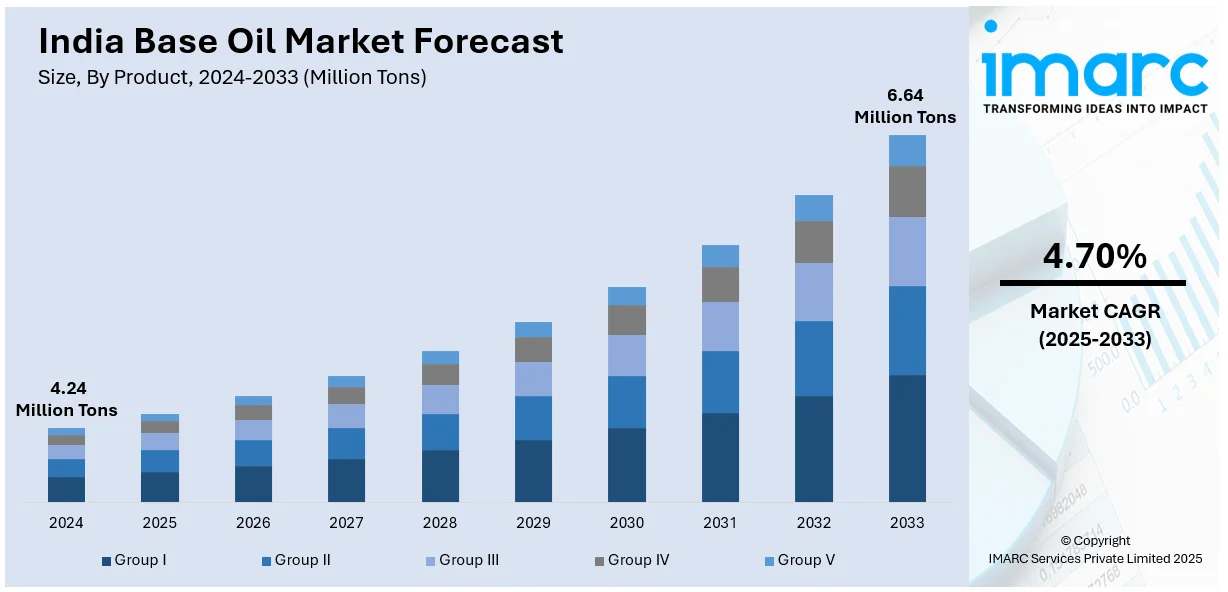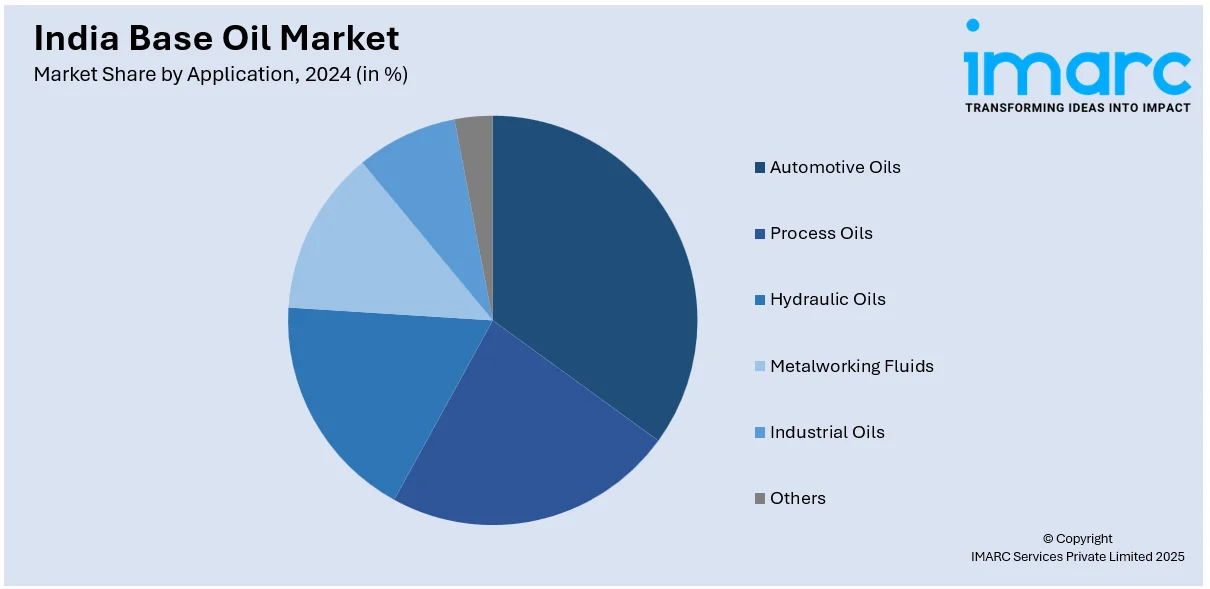
India Base Oil Market Size, Share, Trends and Forecast by Product, Application, and Region, 2025-2033
India Base Oil Market Overview:
The India base oil market size reached 4.24 Million Tons in 2024. Looking forward, IMARC Group expects the market to reach 6.64 Million Tons by 2033, exhibiting a growth rate (CAGR) of 4.70% during 2025-2033. The market is driven by stricter emission norms (BS-VI), rising demand for high-performance lubricants, and the automotive industry’s shift toward premium Group II/III base oils. Sustainability initiatives, government regulations, and cost-effective re-refining technologies are also improving demand for eco-friendly base oils, thereby supporting domestic production and augmenting the India base oil market share.
|
Report Attribute
|
Key Statistics
|
|---|---|
|
Base Year
|
2024
|
|
Forecast Years
|
2025-2033
|
|
Historical Years
|
2019-2024
|
| Market Size in 2024 | 4.24 Million Tons |
| Market Forecast in 2033 | 6.64 Million Tons |
| Market Growth Rate 2025-2033 | 4.70% |
India Base Oil Market Trends:
Growing Demand for High-Quality Group II and III Base Oils
The significant shift toward high-quality Group II and III base oils, driven by stringent environmental regulations and changing automotive industry standards, is expanding the India base oil market share. With the Indian government implementing stricter emission norms, including BS-VI, lubricant manufacturers are increasingly adopting advanced base oils to meet performance requirements. Group II and III base oils offer better oxidation stability, lower sulfur content, and improved viscosity index, making them ideal for high-performance engine oils. Additionally, the rise of electric vehicles (EVs) is pushing demand for thermally stable lubricants, further increasing the adoption of premium base oils. India is leading the electric vehicle revolution across emerging Asia, creating a USD 1.3 Trillion investment opportunity by 2030 as electric two- and three-wheelers proliferate. In the year 2023, India emerged as a world leader in electric three-wheeler sales with 580,000 units and 60 percent market share and also totaled 880,000 e-scooter sales for second place globally. The rise of electric vehicles is driving the need for premium base oils. Refineries are also investing in upgrading their facilities to produce higher-grade base stocks, reducing reliance on imports. As a result, domestic production of Group II and III base oils is expected to grow, catering to both local and export markets, creating a positive India base oil market outlook.

To get more information on this market, Request Sample
Increasing Focus on Sustainability and Re-refined Base Oils
Sustainability is becoming a major trend in the market, with a growing emphasis on re-refined base oils to support circular economy initiatives. Used lubricating oils, which were previously discarded or burned, are now being reprocessed into high-quality re-refined base oils through advanced re-refining technologies. This trend aligns with global environmental concerns and India's push toward reducing carbon emissions. Government policies, such as the Extended Producer Responsibility (EPR) framework, are encouraging lubricant manufacturers to adopt eco-friendly practices, including the use of re-refined base stocks. According to an industry report, India's used oil recycling industry is uncoordinated and needs phased objectives and regulatory changes to drive via production of re-refined base oil (RRBO). The lubricants market is anticipated to grow to 5-6 Million Metric Tons by 2031, with the Extended Producer Responsibility (EPR) mandate growing from a range of 0.08-0.09 Million Metric Tons currently to 0.85-1.00 Million Metric Tons, supporting circular economy initiatives within the base oil sector. Additionally, cost advantages and the availability of used oil feedstock are driving investments in re-refining plants across the country. As awareness about sustainable lubricants grows among consumers and industries, the demand for re-refined base oils is rising, supporting the India base oil market growth.
India Base Oil Market Segmentation:
IMARC Group provides an analysis of the key trends in each segment of the market, along with forecasts at the country level for 2025-2033. Our report has categorized the market based on product and application.
Product Insights:
- Group I
- Group II
- Group III
- Group IV
- Group V
The report has provided a detailed breakup and analysis of the market based on the product. This includes group I, group II, group III, group IV, and group V.
Application Insights:

- Automotive Oils
- Process Oils
- Hydraulic Oils
- Metalworking Fluids
- Industrial Oils
- Others
A detailed breakup and analysis of the market based on the application have also been provided in the report. This includes automotive oils, process oils, hydraulic oils, metalworking fluids, industrial oils and others.
Regional Insights:
- North India
- South India
- East India
- West India
The report has also provided a comprehensive analysis of all the major regional markets, which include North India, South India, East India, and West India.
Competitive Landscape:
The market research report has also provided a comprehensive analysis of the competitive landscape. Competitive analysis such as market structure, key player positioning, top winning strategies, competitive dashboard, and company evaluation quadrant has been covered in the report. Also, detailed profiles of all major companies have been provided.
India Base Oil Market News:
- January 18, 2025: Indian Oil Corporation Limited (IOCL) launched trial operations at its integrated lube complex located at Manali in Chennai, with an investment of INR 1,400 Crore (USD 169 Million). The lant that will have an annual capacity of 672 TMTPA will make it the second-largest in the world. The plant will utilize base oil from CPCL Refinery and Chennai Port to produce environment-friendly lubricants contributing to India's self-sufficiency in the base oil segment.
India Base Oil Market Report Coverage:
| Report Features | Details |
|---|---|
| Base Year of the Analysis | 2024 |
| Historical Period | 2019-2024 |
| Forecast Period | 2025-2033 |
| Units | Million Tons |
| Scope of the Report |
Exploration of Historical Trends and Market Outlook, Industry Catalysts and Challenges, Segment-Wise Historical and Future Market Assessment:
|
| Products Covered | Group I, Group II, Group III, Group IV, Group V |
| Applications Covered | Automotive Oils, Process Oils, Hydraulic Oils, Metalworking Fluids, Industrial Oils, Others |
| Regions Covered | North India, South India, East India, West India |
| Customization Scope | 10% Free Customization |
| Post-Sale Analyst Support | 10-12 Weeks |
| Delivery Format | PDF and Excel through Email (We can also provide the editable version of the report in PPT/Word format on special request) |
Key Benefits for Stakeholders:
- IMARC’s industry report offers a comprehensive quantitative analysis of various market segments, historical and current market trends, market forecasts, and dynamics of the India base oil market from 2019-2033.
- The research report provides the latest information on the market drivers, challenges, and opportunities in the India base oil market.
- Porter's five forces analysis assist stakeholders in assessing the impact of new entrants, competitive rivalry, supplier power, buyer power, and the threat of substitution. It helps stakeholders to analyze the level of competition within the India base oil industry and its attractiveness.
- Competitive landscape allows stakeholders to understand their competitive environment and provides an insight into the current positions of key players in the market.
Key Questions Answered in This Report
The base oil market in India reached a volume of 4.24 Million Tons in 2024.
The India base oil market is projected to exhibit a CAGR of 4.70% during 2025-2033, reaching a volume of 6.64 Million Tons by 2033.
The market is driven by expanding automotive and industrial sectors, where lubricants are essential. Rising demand for higher-performance lubricants is encouraging the use of advanced base oils. Industrial growth, construction activity, and machinery usage across sectors further boost consumption. Additionally, increased focus on equipment maintenance and longevity supports sustained demand for quality base oils.
Need more help?
- Speak to our experienced analysts for insights on the current market scenarios.
- Include additional segments and countries to customize the report as per your requirement.
- Gain an unparalleled competitive advantage in your domain by understanding how to utilize the report and positively impacting your operations and revenue.
- For further assistance, please connect with our analysts.
 Request Customization
Request Customization
 Speak to an Analyst
Speak to an Analyst
 Request Brochure
Request Brochure
 Inquire Before Buying
Inquire Before Buying




.webp)




.webp)












